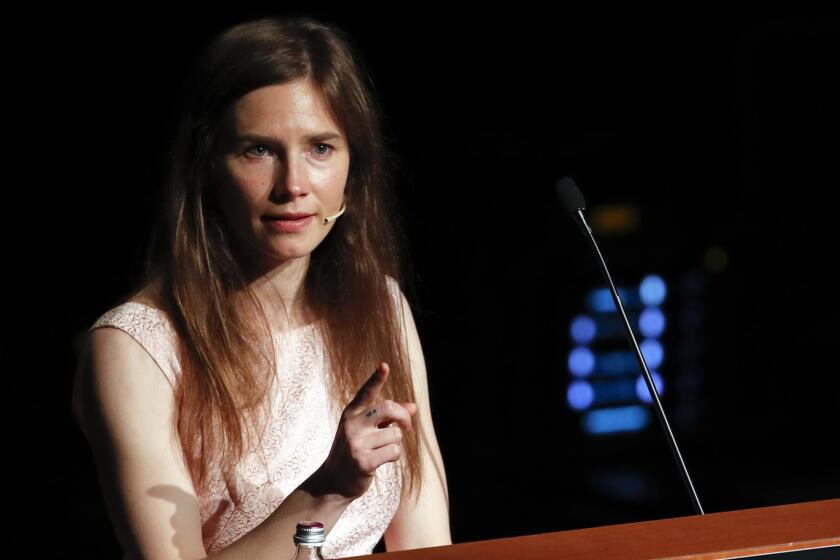Guy Stockwell, 68; TV and Film Actor Taught the Craft
- Share via
Guy Stockwell, an actor in about 30 movies and 250 television shows, a respected acting coach and the older brother of actor Dean Stockwell, has died at 68.
Stockwell died of undisclosed causes last Wednesday at Yavapai Regional Medical Center near Prescott, Ariz. He had lived in Prescott for the last five years.
The sons of Broadway singer and actor Harry Stockwell, Guy and Dean started out as child actors.
Guy made his stage debut at age 5 in “The Innocent Voyage,” and a few years later had a small role as a boy in the 1946 motion picture “The Green Years.”
But Guy Stockwell, unlike his younger brother, hit his acting stride not as a boy but as a young man in the quirky 1959 mystery “This Rebel Age” and in the 1960 comedy “Please Don’t Eat the Daisies.”
His best big-screen role came in 1966 with the remake of “Beau Geste,” with Stockwell in the title role and Leslie Nielsen and the late Doug McClure as his brothers struggling with their evil French Foreign Legion commander, portrayed by the late Telly Savalas.
Stockwell also found major success on the small screen in the 1960s as a regular on two much-loved series.
In 1961 and 1962, he joined the late Gardner McKay sailing the South Pacific on the Tiki as first mate Chris Parker in “Adventures in Paradise.”
Stockwell was one of 10 actors joining Richard Boone for repertory plays on the TV anthology series “The Richard Boone Show” in 1963.
Stockwell’s guest roles on television spanned four decades of such popular prime-time series as “Perry Mason” and “Wagon Train” in the 1950s, “Mannix” and “The F.B.I.” in the 1960s, “The Streets of San Francisco” and “ChiPs” in the 1970s, and “Simon and Simon,” “Murder, She Wrote,” “Matlock” and “Quantum Leap” in the 1980s.
The actor also appeared in such movies for television as “Everybody’s Baby: The Rescue of Jessica McClure” in 1989 and “Unspeakable Acts” and “Columbo Goes to College,” both in 1990.
Stockwell, unlike his more famous actor brother, gravitated more to stage than screen and performed around the country in such classic plays as “The Seagull” and “The Misanthrope.”
But from about 1960 on, Stockwell built another career as an acting coach and producer of plays for new talent in small Los Angeles theaters, including Stage II on Melrose Avenue.
He helped create the Los Angeles Art Theater and starred there in the title role of “Hamlet” and in his own adaptation of “Crime and Punishment.”
In teaching, Stockwell said he patterned his work on that of Russian-born actor and teacher Sergeivich Stanislavsky, who died in 1938.
Stanislavsky, Stockwell explained for The Times in 1986, studied actors and asked them how they did certain expressions or gestures that appealed to him.
“In effect, what Stanislavsky was doing was modeling excellent behavior,” he said.
“And once he had a clear enough model, shaking all the nonsense out of it, he taught other people the same model--and lo and behold, they became excellent actors.”
Stockwell also sought to shortcut psychoanalytic methods employed by the renowned teacher Lee Strasberg and others who insisted that an actor understand a situation and then wait for emotion or motivation.
Instead, Stockwell said, with his method he could teach an inhibited female student to scream for a horror movie audition quite quickly.
“If you’d ask any teacher how long it would take to alter the inhibition, they’d tell you, conservatively, three, four months--lots of sensory work,” he said.
“But I had her doing it in three minutes. Essentially, I told her, ‘There’s no reason for you to feel anything. You’re quite capable of faking it.’
“And when she realized she didn’t have to feel--only behave--she was fine [and] screamed bloody murder.
“Acting,” said the teacher who also enjoyed acting, “should not be painful, but play.”
Stockwell also taught in the UCLA master’s program for acting.
In addition to his brother, Stockwell is survived by his first wife, Suzanne; and three children.
More to Read
The complete guide to home viewing
Get Screen Gab for everything about the TV shows and streaming movies everyone’s talking about.
You may occasionally receive promotional content from the Los Angeles Times.




